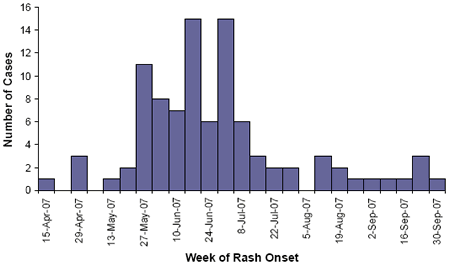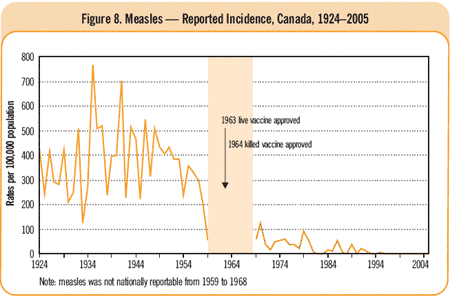Common menu bar links
Institutional links
Diseases & Conditions
Health & Safety
Research & Statistics
Agency Information
Search Box
E-mail this page
Information for Health Professionals
Updated: February 19, 2008
Measles
Measles (rubeola) is a leading cause of vaccine-preventable deaths in children worldwide. There has been a marked reduction in incidence in countries where vaccine has been widely used, but measles remains a serious and common disease in many parts of the world. Complications such as otitis media and bronchopneumonia occur in about 10% of reported cases, even more commonly in those who are poorly nourished and chronically ill, and in infants < 1 year of age. Measles encephalitis occurs in approximately 1 of every 1,000 reported cases and may result in permanent brain damage. Measles infection causes subacute sclerosing panencephalitis (SSPE), a rare but fatal disease. In developed countries, including Canada, death is estimated to occur once in 3,000 cases. Measles during pregnancy results in a higher risk of premature labour, spontaneous abortion and low birth weight infants. Canada has made great progress in its goal of measles elimination, and endemic transmission of measles has been interrupted.
Epidemiology
Before the introduction of the vaccine, measles occurred in cycles with an increasing incidence every 2 to 3 years. At that time, an estimated 300,000 to 400,000 cases occurred annually. Since the introduction of vaccine, the incidence has declined markedly in Canada (see Figure 8). Between 1989 and 1995, in spite of very high vaccine coverage, there were many large outbreaks involving mainly children who had received one dose of measles vaccine. It was estimated that 10% to 15% of immunized children remained unprotected after a single dose given at 12 months of age, a proportion large enough to allow circulation of the virus. These primary vaccine failures were mainly caused by the interference of persisting maternal antibody. The currently recommended second dose aims to achieve immunity in children who did not respond to their first dose.
In 1996/97, every province and territory added a second dose to its routine schedule, and most conducted catch-up programs in school-aged children with measles or measles/rubella vaccine. These interventions achieved vaccine coverage for the second dose in excess of 85%, reducing the proportion of vulnerable children to such a negligible level that viral transmission could not be sustained.
Measles elimination within a population should be possible, as an effective vaccine is available and there is no non-human reservoir or source of infection. During the XXIV Pan American Sanitary Conference in September 1994, representatives from Canada and other nations resolved to eliminate measles in the Americas by the year 2000. In Canada, sustained transmission has been eliminated by our current schedule and high vaccine coverage. However, as expected, imported cases continue to occur. Secondary spread from these imported cases is self-limited and involves the few Canadians who are still vulnerable. The largest outbreaks have occurred in isolated groups that are philosophically opposed to immunization. Nevertheless, there is very limited secondary transmission of measles in the general population. Between 2002 and 2006, the number of measles cases reported annually ranged from 6 (2005) to 16 (2003) with a yearly average of 10.
Most other countries in North, Central and South America have also succeeded in eliminating sustained transmission. In 2005 fewer than 100 measles cases were reported in all of the Western Hemisphere. The situation in other regions is evolving at a slower pace, though measles deaths in Africa have been reduced by 60%, largely through the efforts of The Measles Initiative, a cooperative group led by the Red Cross, in partnership with UNICEF, the Centers for Disease Control and Prevention, the World Health Organization and the United Nations Foundation.
The greatest challenge for future years will be to continue achieving vaccine coverage rates of 95% or more as measles becomes increasingly unfamiliar to Canadian parents. Immunization against measles will continue to be necessary in Canada until global elimination of the disease has been achieved.
Source: Canadian Immunization Guide, 7th edition, 2006
Update on Measles Outbreak in Quebec
(week of April 15, 2007 to September 30, 2007)
There was increased measles activity in 7 out of 18 health regions in Quebec. As of the week starting November 18th, there was a total of 95 confirmed cases of measles in Quebec. A confirmed case meets one of two criteria: (i) laboratory-confirmation of measles infection OR (ii) clinical compatibility with measles infection and an epidemiologic link to a laboratory-confirmed case. Only confirmed cases which meet this national case definition were being counted and reported. Probable and suspect cases still need to be identified for prompt and appropriate medical and public health management (e.g. diagnosis, specimen collection, laboratory testing, clinical care, as well as public health reporting, follow-up and intervention).
The first reported case had rash onset the week of April 15, 2007 and the last reported case had rash onset the week of September 30, 2007 (Figure 1). Where immunization status was known, nearly all of the cases reported in Quebec (79/86) were susceptible individuals who are under-immunized (i.e. 1 dose of measles vaccine) or not immunized at all. In the latter case, these were mainly individuals who oppose vaccination for philosophical reasons. Ten cases were hospitalised and to date, no serious complications have been reported.
Confirmed cases ranged in age from 1 to 46 years (median 10.0, average 13.5). Over half (54.7%) of cases were between the ages of 1 and 10 years. Half (50.5%) of the cases were male.
Figure 1: Confirmed* Measles Cases Reported in Quebec, Weeks starting April 15, 2007 - September 30, 2007 (N= 95)

* A confirmed case is either a laboratory-confirmed case OR clinically compatible and linked to a laboratory-confirmed case.
There were several community exposure settings including a fashion event, a national conference with participants from around the world, a theatrical event, three elementary schools with sub-optimal vaccination coverage rates, a public swimming pool as well as public transit, two workplace settings and several clinics and waiting rooms. To-date, no known cases of measles related to the outbreak in Quebec were reported in any other provinces or territories.
Virus genotyping identifies and aids the global tracking of circulating measles virus strains. Genotyping can also be used to help link cases to clusters and to provide evidence that indigenous transmission has been eliminated. The National Microbiology Laboratory identified two D4 strains associated with outbreak in Quebec, suggesting two separate importations.
Public health and primary care providers should remain vigilant in the detection, appropriate testing and public health follow-up of febrile rash illness. Any suspect measles cases, particularly those with travel history to areas with endemic or epidemic measles, should be reported as soon as possible through the regular channels.

